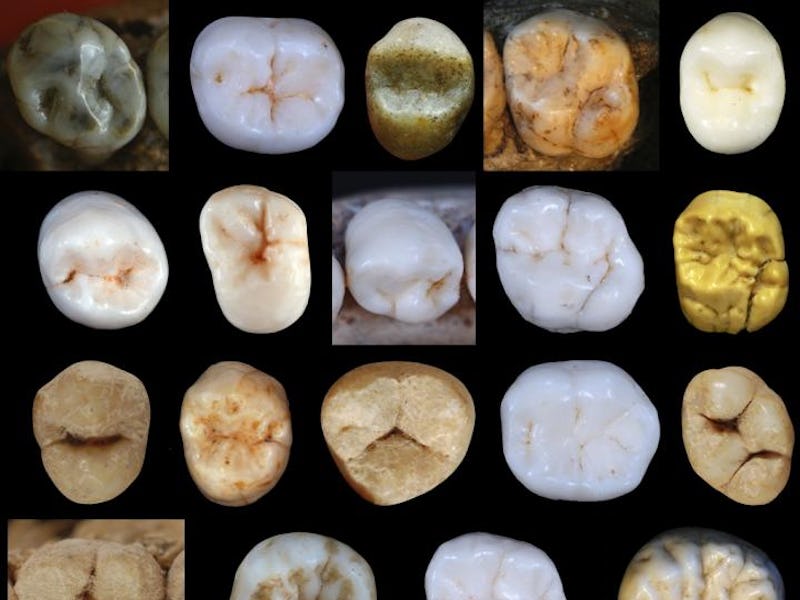Ancient Teeth Reveal the Ancestor Humans Most Likely Share With Neanderthals
This study builds a case for the last common ancestor we share with Neanderthals.

We have 32 clues buried in our mouths. Evaluating these clues is one of the most reliable ways to track our evolution, as teeth are more than just chomping tools: The presence or absence of cusps, crests, and ridges can be the difference between human species. And an anthropologist recently used these subtle features of teeth to determine when our species, Homo sapiens, split from Neanderthals, changing what we know about the timeline that led to us.
In a study released Wednesday in Science Advances, University College London fellow Aida Gómez-Robles, Ph.D., shows evidence that the lineages of Neanderthals and modern humans diverged at least 800,000 years ago. This is a more distant point in history than prior studies have identified: Previous DNA analyses indicated that the species split between 300,000 and 500,000 years ago.
Gómez-Robles argues that the previously identified divergence time is not compatible with her anatomical observations, though. She explains to Inverse that the most important trait teeth hold for anthropologists is that they evolved at very similar rates across all hominin species, which allows experts to build a timeline.
Artist representation of the Sima de los Huesos hominins.
For example, researchers agree that the first human-like traits to appear in the hominin fossil record are bipedal walking and small, blunt canines — far different from the long canines seen in chimpanzees. Meanwhile, the teeth of ancient Australopithecus evolved to have larger molars and thicker enamel than their forebears. Molars changed again in the earliest Homo species that came after Australopithecus, too.
Gómez-Robles’ study focuses on the dental shape of eight different hominin species, paying special attention to an early Neanderthal population that lived at the Sima de los Huesos site in Spain. This group is considered the closest we have to a divergence point between Neanderthals and modern humans.
There are small-scale variations that separate the teeth of Neanderthals from those of modern humans — differences that likely aren’t attached to strong functional implications, but are consistent and nonetheless differentiate the species. The Sima de los Huesos hominins have very small premolars and molars that show multiple similarities to the teeth of classic Neanderthals. But the teeth are not entirely the same, even though these hominins were early Neanderthals.
A jaw bone found in the Sima de los Huesos cave in 1976.
That means that, for the Neanderthal dental evolutionary date to make sense in the context of other time stamps scientists know, the moment of species divergence between modern humans and Neanderthals has to be pushed back. Gómez-Robles explains that any divergence time more recent than 800,000 years would have meant that some unexpectedly fast dental evolution was happening — an unlikely scenario.
To Gómez-Robles, the most important implication of this study is how it influences the overall interpretation of the hominin fossil record — as well as our hunt for the common ancestor we share with Neanderthals.
“When looking for the last common ancestor of Neanderthals and modern humans, Homo heidelbergensis tends to be the most likely ancestor,” Gómez-Robles says. “However, according to my results Homo heidelbergensis cannot occupy that evolutionary position because it postdates the divergence between Neanderthals and modern humans.”
That means we need to look back to older species when looking for the common ancestor. Gómez-Robles argues that, based on timing alone, the species that is dated to the “correct” period of time — approximately 800,000 years ago — is Homo antecessor.
This candidate lived between 800,000 and 1.2 million years ago in Europe. Its remains are, so far, the oldest human remains found in Europe (its name translates to “human pioneer”). But its existence as a species is controversial as well, with some researchers believing it to be an early member of the H. heidelbergensis population, rather than its own species.
Meanwhile, H. antecessor’s discoverers have consistently argued that it shares more traits with us than it does with H. heidelbergensis, so it’s likely to be the common ancestor between Homo sapiens and Neanderthals. This new study lends credibility to that argument — and could mean we’re one step closer to truly knowing our family tree.
Abstract:
The origin of Neanderthal and modern human lineages is a matter of intense debate. DNA analyses have generally indicated that both lineages diverged during the middle period of the Middle Pleistocene, an inferred time that has strongly influenced interpretations of the hominin fossil record. This divergence time, however, is not compatible with the anatomical and genetic Neanderthal affinities observed in Middle Pleistocene hominins from Sima de los Huesos (Spain), which are dated to 430 thousand years (ka) ago. Drawing on quantitative analyses of dental evolutionary rates and Bayesian analyses of hominin phylogenetic relationships, I show that any divergence time between Neanderthals and modern humans younger than 800 ka ago would have entailed unexpectedly rapid dental evolution in early Neanderthals from Sima de los Huesos. These results support a pre–800 ka last common ancestor for Neanderthals and modern humans unless hitherto unexplained mechanisms sped up dental evolution in early Neanderthals.